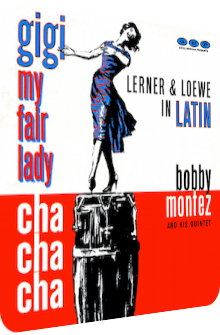
Bobby Montez
Lerner & Loewe In Latin
1959
Who is the fourth king of Exotica, you know, the one behind Martin Denny, Arthur Lyman and Les Baxter, and did I even name them in the right order? Many names come to mind, from Cal Tjader over Gene Rains to Pérez Prado. What about former bandleader and vibraphonist Bobby Montez (1934–2003) who later went on to become an architect for landscapes and gardens? Fans know about his debut Jungle Fantastique! (1958) whose bold title lives up to its promise. Since it is the only album that has officially been reissued and remastered, there is no easy way to get hold of a pristine vinyl copy of Montez’s subsequent works. Mediocre vinyl rips are the next-best thing, as prices go sky-high when LP’s appear on eBay and other market places.
One of Montez’s greatest albums next to Jungle Fantastique! is Lerner & Loewe In Latin, released in 1959 on the GNP Crescendo label and later in 1960 as My Fair Lady Latin. Spanning eleven compositions from two musicals – 1956’s My Fair Lady and 1958’s Gigi – the music of Alan Jay Lerner and Frederick Loewe is successfully transplanted into a technicolor jungle. The title sounds rather technical and not that imaginative, but believe me, it offers more of the same structures that made Jungle Fantastique! so great, and then some. Featuring bandleader Bobby Montez on the vibraphone, Carlos Ortega Avelar on the piano, Jimmy Baiz on the double bass as well as the talent of two dedicated drummers, conguero Louis Miranda and timbalist/timbalero Miguel Gutierrez, there is many a classic to rediscover in newly polyfoil flowerage.
Even though the album title says it all, the transformation has to be heard to be believed: the material of My Fair Lady is mercilessly stripped off its symphonic alloy and coated in the humid-arduous odours of the tropics. On The Street Where You Live is a prime example of Montez’s vivid arrangement, not just due to its state as the opener. Conguero Miranda and timbalero Gutierrez create a fast-paced rhythm with their signature instruments, pianist Avelar plays the recognizable melodies, shuttling between feverish verve and dreamy interstices, all the while Montez remains in the background, adding his vibraphone punctilio as ornamental devices only. Finally, bassist Baiz delivers bone-dry low frequencies that serve as the easygoing fundament of a gorgeously flowing percussion-supercharged void.
This is just the kick-off of the things to come, and yet it evokes the exuberant verve the quintet is unleashing time and again. The gentlemen don’t rely on exclusively fast interpretations though. I’ve Grown Accustomed To Her Face sits on the opposite side of the spectrum, enchanting with its wordless chants akin to a true Space-Age choir, the laid-back rhythm which allows to absorb the various textures and hollow trademark sound of the congas and timbales as well as the vibraphone’s glacial-vitreous cocktail afterglow that is retrojected onto the warm vermillion hue of the piano. The melody is a tad more complex, but the glassy aura of Montez’s instrument emits dew drops of purity that lessen the labyrinthine tone sequences.
While I Could Have Danced All Night returns to the magic of the plinking piano which becomes entangled in a Salsa vortex complete with raspy guiros and partially dun-colored arabesques before the euphonious lead melody takes over again, Get Me To The Church On Time is both a hillbilly cataract and comic relief which sees the hefty friction of the guiro enshrined in a Honky Tonk peritoneum before the gorgeously beatific melody of Wouldn’t It Be Lovely appears in a conga coppice with timbale tendrils. Mellow and sun-dappled yet exhilaratively fast, it is a sure highlight of side A whose endpoint is embodied by Show Me, a Tito Puente-esque Guaguancó highlight that lures with its green jungle drums and coupled piano-vibe serpentines.
Side B is solely dedicated to the endemic sounds of Gigi, although they are naturally transmogrified yet again. When Bobby Montez’s quintet plays I’m Glad I’m Not Young Anymore, its assessment is neglected via heavily swinging guiro-accompanied piano cascades and woodpeckers made of timbales. Additional “baia” chants amplify the fuego further. The eponymous Gigi meanwhile surprises with a classic piano prelude whose melody is then intertwined with tastily punchy conga beats. The drums are situated in front of the piano, making them seem like the frontmost attraction of this parallax diorama. And another thing is noticeable: the gentleness and whirling mauve-tinted esprit of the original survives and shimmers through the jungle cracks. The adjacent The Night They Invented Champagne brings back the smoking-fast Samba rhythms, short wordless vocal performances and a titration that is equally reliant on the tonality silent movie era and amethystine coruscation of the vibraphone.
Up next is Thank Heaven For Little Girls, and it is here where the dreaminess of the original is superimposed on the tropical Merengue yet again, emanating insouciance and velvet mellifluousness with every key of the piano. The croaking guiro and revved up drum segues is the only raucous element in this blissful concoction. The Parisians rounds off the album with shadier piano tones that would be much more fitting in a Tango. However, this is a clear cut Mambo, albeit a rufescent one with helicoidal vibes and recondite lovestoned harmonies, making this the utmost Latin metamorphosis of the whole album.
Lerner & Loewe In Latin is a downright gorgeous blueprint and great example of how you can exotify or exoticize evergreens and material off musicals. There is often something amiss when well-known aural artifacts are altered, be it symphonic renditions of The Beatles, Techno mixes of Pop material or panpipes-infested New Age versions of piano arrangements. Fans keep complaining that these productions lack soul, that they are created to cash in, and shiver me timbers if I’m not among those denizens. You can find many a review at AmbientExotica in this regard. Bobby Montez and his quintet create something magnificent though, an album that caters to Latin, Exotica and Space-Age fans alike. Whether it’s the humming vocals, the punchy plasticity of the percussion and drums, the thermal heat of the piano or the array of different tempos, Lerner & Loewe In Latin is not too vivid a title, but the self-explanatory wording does radiate truthfulness.
The album is evenly balanced, neither too flamboyant nor overly lovelorn. Verdured greeneries, hot city vibes, celebratory elements as well as contemplative counterpoints that live up to the self-reflective thought processes of the characters in the musicals, Lerner & Loewe In Latin is a feisty work, truly exotic and unsurprisingly Latin at the same time. The occasional chants and shout-outs of the quintet never feel forced, nor are they perceived as gimmicky. They are carefully dosed in order to not take over and destroy the link to the original. Said link is strongly perceptible all the time, as the melodies remain intact even when improvised intersections and foreign matter instruments swallow the lachrymose appearance of Lerner & Loewe’s classics. There’s no denial: this has to be re-issued!
Exotica Review 472: Bobby Montez – Lerner & Loewe In Latin (1959). Originally published on Jun. 10, 2016 at AmbientExotica.com.
